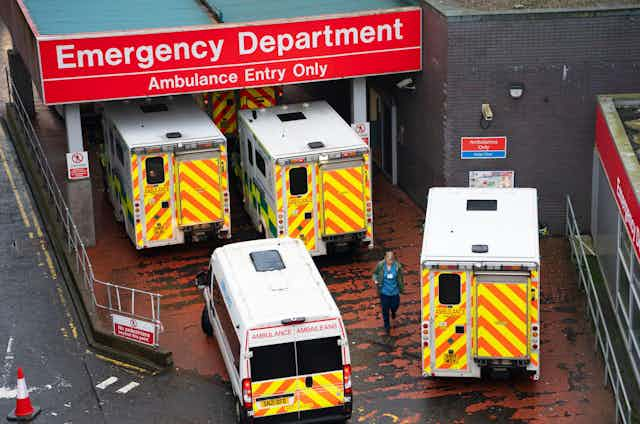The NHS is having its worst winter in recent memory with strikes, record ambulance and A&E waiting times, and fears of excess deaths caused by delays in treatment. What hope is there for improvement in 2023?
It’s hard to find any cause for optimism in the current crisis. However, the worst elements of the crisis may be ameliorated as we move further away from the acute phase of the pandemic. Some recent trends in the workforce might also improve the situation.
The mismatch between supply and demand is causing the crisis in the NHS. Supply of healthcare in the NHS is constrained by workforce problems such as higher numbers of staff off sick, early retirements – including those caused by pension problems for doctors – as well as Brexit and lower immigration during the pandemic. The best evidence for the size of the workforce crisis is the number of vacancies in the NHS: the latest data shows that there are 133,446 vacancies, which is 9.7% of the NHS workforce.
The picture is particularly bad among nurses with 47,496 vacancies or 11.9% of the total nursing workforce. High vacancy rates are not caused by lack of funding per se, as a vacancy implies there are funds available to recruit additional staff. But financial issues like declining real pay for nurses make it harder to attract young people into nursing, and probably more importantly, to retain them in the profession in the long term.
At the same time, demand is as high as ever as there appears to be a “rebound effect” in patient demand following a quiet period during the pandemic. Both GP appointments and hospital emergency attendances are at record levels. And we know this is not just a UK NHS phenomenon as it can also be seen around the world, including in the US.
Part of the high demand this winter is due to the “twindemic” of flu and COVID affecting our health system this winter. In late December 2022, we have seen about 8,000 flu patients and 6,000 COVID patients being admitted to hospital every week.
On this front, there are both pessimistic and optimistic views about future prospects. On one hand, neither flu nor COVID is likely to go away anytime soon, so we will probably be living with both as a major source of sickness in the population for the foreseeable future.
Yet there is reason to suspect that the flu season (as well as other viral infections, such as RSV) is so bad this year is due to an “immunity debt” in the population. Fewer people were exposed to viruses like flu and RSV during the pandemic, so more are susceptible this winter than usual.
This “debt” should be paid by next winter with all the infections we are seeing now building up immunity for the future, so we should see more “normal” flu seasons in the future.

Expanding workforce
Another chink of light comes from looking at data on the health workforce. In mid-2020, in preparation for the end of the Brexit “transition period”, the UK government introduced the “NHS visa” to make it easier for health and social care workers to move to the UK. This was partly a recognition of workforce pressures in the NHS and also a response to Brexit making it harder for Europeans to move to the UK.
Initially, the numbers of visas being issued in 2020 and 2021 were modest, but in 2022, the number of visas issued started to grow quickly from just over 30,000 in the second quarter of 2022 to over 45,000 in the third quarter.
There will be a lag between visas being issued and the workers starting to work in the UK, but this addition to the health workforce should start to ease workforce pressures and hopefully reduce NHS vacancies. Crucially, the visa also covers workers in social care, where workforce shortages are responsible for some of the backlogs into hospitals and emergency care.
Another positive workforce trend is the growth in student nurses that we’ve seen since the onset of the pandemic. While they have dipped again in the most recent data, the numbers entering nursing courses is still substantially higher than before the pandemic.
Finally, another positive development would be the prospect of a pay deal for nurses and other health workers that helps to retain existing staff and stop any further strikes.
Other challenges remain, including the need for investment to build or expand hospitals to increase capacity alongside the workforce.
Many NHS performance levels are below target, and things won’t improve very quickly. But some chinks of light remain that some of the biggest underlying problems can begin to be addressed in 2023.

